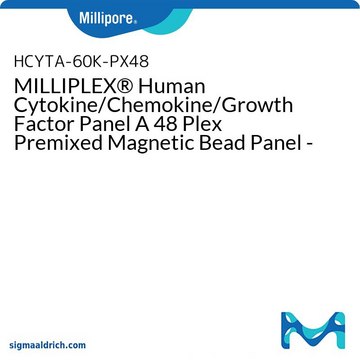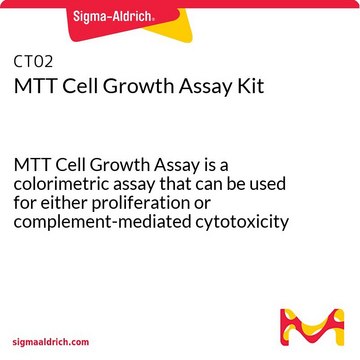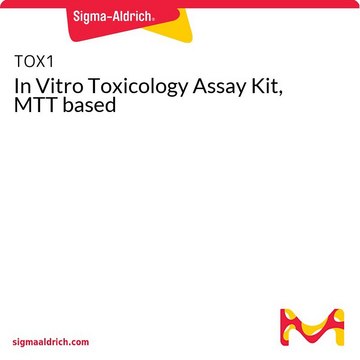Kluczowe dokumenty
CELLPRO-RO
Roche
Cell Proliferation Reagent WST-1
suitable for protein quantification, suitable for cell analysis, detection, solution
Synonim(y):
cell proliferation reagent, wst-1
About This Item
Polecane produkty
Formularz
solution
Poziom jakości
zastosowanie
sufficient for ≤2,500 tests (11644807001)
sufficient for ≤800 tests (05015944001)
opakowanie
bottle of 25 mL (11644807001)
bottle of 8 mL (05015944001)
producent / nazwa handlowa
Roche
warunki przechowywania
protect from light
metody
protein quantification: suitable
optymalne pH
8.0(for physiological conditions our product is buffered pH 7.3)
λmaks.
440-480 nm
Zastosowanie
cell analysis
detection
metoda wykrywania
colorimetric
temp. przechowywania
−20°C
Opis ogólny
Ready-to-use solution, containing WST-1 and an electron coupling reagent.
Zastosowanie
- Analysis of cytotoxic and cytostatic compounds, such as anti-cancer drugs and other pharmaceutical compounds
- Assessment of growth inhibitory antibodies and physiological mediators
Cechy i korzyści
- Convenient: Benefit from a ready-to-use reagent.
- Safe and Easy: Eliminate radioactive isotopes, washing steps, and additional reagents.
- Accurate: The absorbance obtained strongly correlates to the cell number.
- Sensitive: Detect low cell numbers.
- Fast: Process a large number of samples using a multi-well ELISA reader.
Zasada
Cells grown in a 96-well tissue culture plate are incubated with the WST-1 reagent for 0.5 - 4 hours. After this incubation period, the formazan dye formed is quantitated with a scanning multi-well spectrophotometer (ELISA reader). The measured absorbance directly correlates to the number of viable cells.
Cell proliferation and viability assays are of particular importance for routine applications in cell biology. Tetrazolium salts (e.g., MTT, XTT, WST-1) are particularly useful for this type of analysis. Tetrazolium salts are cleaved to formazan by the succinate-tetrazolium reductase system (EC 1.3.99.1) which belongs to the respiratory chain of the mitochondria, and is only active in metabolically intact cells.
Uwaga dotycząca przygotowania
Using the 100 μl/well cell culture volume, one vial will be sufficient to perform 2500 tests (25 microplates).
Note: If the cells are cultured in 200 μl/well, add 20 μl/well Cell Proliferation Reagent WST-1.
Storage conditions (working solution): 2 to 8 °C
Note: When precipitates or turbidity are observed upon thawing, warm up the solution to 37 °C for 2 to 10 minutes and agitate to dissolve the precipitates.Centrifugation is not recommended because the working concentration would decrease. After being dissolved, the WST-1 reagent can be used without any limitations. Please store as follows:
Once thawed, store at 2 to 8 °C, protected from light, for up to four weeks. However please note that the solution may become viscous. If so, warm up the solution to 37 °C for 2 to 10 minutes as described above.
Long storage
For long storage, aliquots of WST-1 can be stored in plastic tubes at -15 to -25 °C until the expiry date.
Inne uwagi
produkt powiązany
Kod klasy składowania
12 - Non Combustible Liquids
Klasa zagrożenia wodnego (WGK)
nwg
Temperatura zapłonu (°F)
No data available
Temperatura zapłonu (°C)
No data available
Wybierz jedną z najnowszych wersji:
Masz już ten produkt?
Dokumenty związane z niedawno zakupionymi produktami zostały zamieszczone w Bibliotece dokumentów.
Klienci oglądali również te produkty
Produkty
Testy komórkowe do proliferacji komórek (BrdU, MTT, WST1), żywotności komórek i eksperymentów cytotoksyczności do zastosowań w badaniach nad rakiem, neuronauką i komórkami macierzystymi.
Cell based assays for cell proliferation (BrdU, MTT, WST1), cell viability and cytotoxicity experiments for applications in cancer, neuroscience and stem cell research.
Protokoły
WST-1 assay protocol for measuring cell viability, proliferation, activation and cytotoxicity. Instructions for WST-1 reagent preparation and examples of applications. Frequently asked questions and troubleshooting guide for WST-1 assay.
Protokół testu WST-1 do pomiarów żywotności i cytotoksyczności komórek z instrukcjami przygotowania, zastosowaniami, często zadawanymi pytaniami i rozwiązywaniem problemów.
Nasz zespół naukowców ma doświadczenie we wszystkich obszarach badań, w tym w naukach przyrodniczych, materiałoznawstwie, syntezie chemicznej, chromatografii, analityce i wielu innych dziedzinach.
Skontaktuj się z zespołem ds. pomocy technicznej













